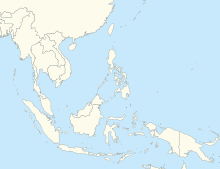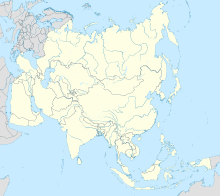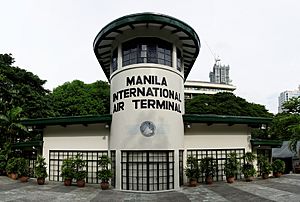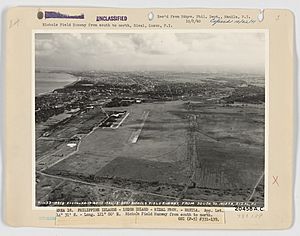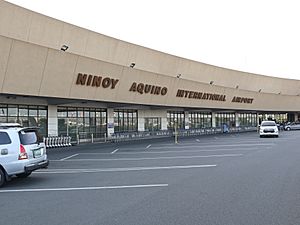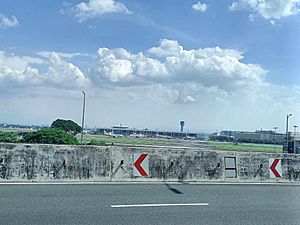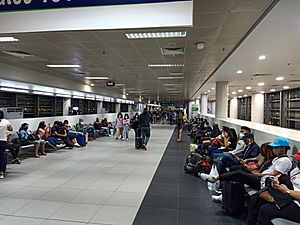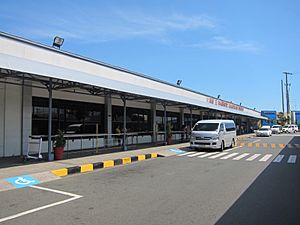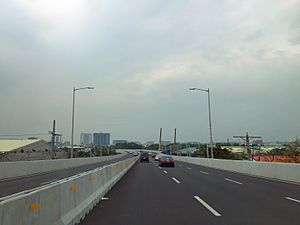Ninoy Aquino International Airport facts for kids
Quick facts for kids
Ninoy Aquino International Airport
Paliparang Pandaigdig ng Ninoy Aquino
|
|||||||||||||||
|---|---|---|---|---|---|---|---|---|---|---|---|---|---|---|---|
 |
|||||||||||||||

MNL in January 2023
|
|||||||||||||||
| Summary | |||||||||||||||
| Airport type | Public / Military | ||||||||||||||
| Owner/Operator | Manila International Airport Authority | ||||||||||||||
| Serves | Greater Manila Area | ||||||||||||||
| Location | Parañaque and Pasay, Metro Manila, Philippines | ||||||||||||||
| Opened | 1948 | ||||||||||||||
| Hub for |
|
||||||||||||||
| Focus city for | Philippines AirAsia | ||||||||||||||
| Time zone | PHT (UTC+08:00) | ||||||||||||||
| Elevation AMSL | 23 m / 75 ft | ||||||||||||||
| Coordinates | 14°30′30″N 121°01′11″E / 14.50833°N 121.01972°E | ||||||||||||||
| Map | |||||||||||||||
| Runway | |||||||||||||||
|
|||||||||||||||
| Statistics (2022) | |||||||||||||||
|
|||||||||||||||
|
Source: Manila International Airport Authority
|
|||||||||||||||
Ninoy Aquino International Airport (NAIA /ˈnaɪə/ NA-yah, locally /nɑː.ˈiː.jə/ na-EE-yah; Filipino: Paliparang Pandaigdig ng Ninoy Aquino; (IATA: MNL, ICAO: RPLL)), originally known as Manila International Airport (MIA), is the main international airport serving the Manila metropolitan area in the Philippines.
It is located between the cities of Pasay and Parañaque, about 7 kilometers (4.3 mi) south of Manila proper and southwest of Makati.
NAIA is the main gateway for travelers to the Philippines and serves as a hub for airlines such as AirSWIFT, Cebgo, Cebu Pacific, PAL Express, and Philippine Airlines. It is also the main operating base for Philippines AirAsia.
It was named after former Philippine Senator Benigno "Ninoy" Aquino Jr., who was assassinated at the airport on August 21, 1983.
NAIA is managed by the Manila International Airport Authority (MIAA), an agency of the Department of Transportation (DOTr).
NAIA and Clark International Airport both serve the metropolitan area. Clark is sited in the Clark Freeport Zone in Pampanga. Clark caters mainly to low-cost carriers because its landing fees are lower. President Gloria Macapagal Arroyo called for Clark to replace NAIA as the primary airport of the Philippines eventually. Two airports are under construction to reduce congestion at the airport. New Manila International Airport is located in Bulacan, while Sangley Point Airport, is located on reclaimed land in Cavite City.
NAIA is operating beyond its designed capacity of 35 million passengers, clogging air traffic and delaying flights. The airport has been tagged by The Guide to Sleeping In Airports, luggage storage app Bounce, and travel blog Hawaiian Islands as one of the worst airports in the Asia-Pacific. In 2018 and 2023 privatizing and improving the airport were pitched.
Contents
History
Early history
Manila's original airport, Grace Park Airfield (also known as Manila North) in Grace Park, Caloocan (then a municipality of Rizal), opened in 1935. It was the city's first commercial airport and was used by the Philippine Aerial Taxi Company (later Philippine Airlines) for its first domestic routes.
In July 1937, Nielson Airport, located in the 45-hectare (4,800,000 sq ft) land in Makati, also then in Rizal, was inaugurated and served as the gateway to Manila; its runways now form Ayala Avenue and Paseo de Roxas. Following World War II and Philippine independence, Grace Park Airfield closed, while Nielson Airport continued to operate it was decommissioned in 1948.
Airport operations were moved to the current site, Nichols Field, due to the flatter terrain, expanse of greenfield land, and the existing USAF base runway (Runway 13/31), which could be used for the airport. The original one-story bungalow terminal was built adjacent to the runway and serves as present-day Terminal 4.
In 1954, the airport's longer international runway (Runway 06/24) and associated taxiways were built, and in 1956, construction was started on a control tower and an international terminal building. The new terminal was designed by Frederico Illustre and was built on the site of Terminal 2. It was inaugurated on September 22, 1961. On January 22, 1972, a fire caused substantial damage to the original terminal, resulting in six casualties.
A slightly smaller terminal was built the following year. This second terminal would serve as the country's international terminal until 1981 when it was converted to a domestic terminal, upon the completion and opening of Terminal 1, a new, higher-capacity terminal. Another fire damaged the old international terminal in May 1985.
Renaming
On August 21, 1983, politician Benigno "Ninoy" Aquino Jr. was assassinated at the terminal's Gate 8 (now Gate 11) after returning to the Philippines from exile in the United States. Aviation Security Command (AVSECOM) personnel escorted Aquino out of the plane to the tarmac, where an agency van awaited. A single gunshot killed him. Several shots were fired, killing alleged assassin, Rolando Galman. Seconds later, gunfire erupted, causing chaos in the plane, the tarmac, and the terminal.
Four years after the incident, during the presidency of Ninoy's widow Corazon Aquino in 1987, Republic Act No. 6639 was enacted without executive approval, renaming the airport in Ninoy's honor. Presently, a body mark of Aquino's assassination is on display at the departures area, while the spot at Gate 8 where he was killed has a memorial plaque. Due to this event, Terminal 1 is nicknamed the "Ninoy Aquino Terminal."
Expansion
Plans for a new terminal were conceived in 1989 when the Department of Transportation commissioned the French company Aéroports de Paris to conduct a feasibility study to expand capacity. The recommendation was to build two new terminals. Construction of Terminal 2 began in 1995 and opened in 1999.
Terminal 3
Construction of a third terminal was proposed by Asia's Emerging Dragon Corporation (AEDP). AEDP eventually lost the bid to PairCargo and its partner Fraport AG of Germany. The structure was originally scheduled to open in 2002. However, a contract dispute between the government of the Philippines and the project's main contractor, Philippine International Air Terminals Co. Inc. (Piatco), delayed the completion and opening. After delays, Terminal 3 partially opened on July 22, 2008. Full operations were initially slated to begin by 2010, then pushed back to 2011, and again to 2014, when Terminal 3 became fully operational on July 31, 2014.
While the original agreement allowed PairCargo and Fraport AG to operate the airport for several years after its construction, followed by a handover to the government, the government offered to buy out Fraport AG for $400 million. Fraport agreed. However, before the terminal could be completed, President Arroyo called the contract "onerous" and formed a committee to evaluate the buyout agreement. In May 2003, the Supreme Court declared the concession contract and the three supplemental construction and operations contracts null and void due to various anomalies.
Certain amendments to the original contract caused it to be nullified. In December 2004, the Philippine government took over the terminal, which led to expropriation proceedings. The government was then negotiating a contract with the builder of the terminal, Takenaka Corporation, because another factor that delayed the terminal's opening was the ongoing investigation into the collapse of part of the terminal's ceiling before its planned opening in March 2006.
Piatco sued the government before the International Chamber of Commerce (ICC). In contrast, Fraport separately sued the Philippine government at the International Center for the Settlement of Investment Disputes (ICSID). In 2007, the ICSID case was decided in favor of the government because of Fraport's violation of the Anti-Dummy Law. However, this decision was annulled in 2010 for violating Fraport's right to be heard. A new claim by Fraport was filed at ICSID in March 2011. Piatco formally withdrew its second application to set aside the earlier ICC ruling that dismissed its claims in December 2011.
The ICC ruling in favor of the Philippine government became final in 2012.

Extortion scam
In October 2015, reports of an extortion scam concerning bullets planted by airport security officials in airline passengers' luggage (dubbed by the local media the tanim-bala [literally plant-bullet] scam) spread, creating a scare among travelers. Former Davao City mayor Rodrigo Duterte, then a presumptive presidential candidate in the 2016 Philippine presidential election, further alleged that a syndicate was behind the incidents. Duterte said the operation had continued for more than two years. Malacañang Palace and the Philippine Senate investigated the incidents. In April 2016, a similar incident occurred.
Rehabilitation and decongestion proposals
On February 12, 2018, a consortium of seven conglomerates consisting of Aboitiz InfraCapital, AC Infrastructure Holdings, Alliance Global, Asia's Emerging Dragon, Filinvest Development Corporation, JG Summit Holdings, and Metro Pacific Investments Corporation submitted a ₱350 billion, or US$6.75 billion, 35-year unsolicited proposal to rehabilitate, expand, operate, and maintain the airport. The consortium's proposal was divided into two phases: the improvement and expansion of terminals in the current NAIA land area and the development of an additional runway, taxiways, passenger terminals, and associated support infrastructure. Changi Airport Consultants Pte. Ltd., was to provide technical support. Singapore's Changi Airport Group eyed a 30-percent stake in this venture.
On March 1, 2018, Megawide Construction Corporation and its India-based consortium partner GMR Infrastructure (the consortium which revamped Mactan–Cebu International Airport), submitted a ₱150 billion, or US$3 billion, proposal to decongest and redevelop the airport. GMR-Megawide did not propose a new runway, claiming that it would not significantly boost capacity.
The NAIA consortium pulled out of the project in July 2020, allowing GMR-Megawide to take over the project. On December 15, 2020, however, the MIAA revoked the original proponent status (OPS) of GMR-Megawide, who then filed a motion for reconsideration. The MIAA denied the motion for reconsideration. In August 2022, the Department of Transportation (DOTr) announced a rebidding of the project within the year.
In April 2023, the Manila International Airport Consortium (MIAC), composed of six organizations (Alliance Global, AC Infrastructure Holdings Corp [under Ayala Corporation], Infracorp Development, Filinvest Development Corporation. and JG Summit Infrastructure Holdings) submitted an unsolicited, ₱100 billion proposal to rehabilitate the airport. Transportation Secretary Jaime Bautista said that the department would review the proposal, adding that they are, in fact, currently consulting with the Asian Development Bank in determining who can be the best operator of the airport and what terms should be imposed when this and other proposals eventually get reviewed. This proposal was subsequently dismissed by the Marcos administration which opted to go through a public–private partnership route instead.
Terminal reassignment program
In February 2018, the Department of Transportation (DOTr) proposed the Schedule and Terminal Assignment Rationalization (STAR) program to mitigate congestion issues across NAIA. As per the rationalization, Terminals 1 and 3 would exclusively handle international flights, while Terminals 2 and 4 would facilitate domestic flights. This revision would deviate from the practice where Terminals 2 and 3 operate both domestic and international flights, contributing to the congestion of both terminals.
Transportation Secretary Arthur Tugade and House Speaker Pantaleon Alvarez supported the initiative, with the latter suggesting that airlines relocate some of their flights to Clark International Airport. However, Senator Grace Poe, chairperson of the Senate Committee on Public Services, voiced concerns that a hasty implementation of terminal reallocations might exacerbate existing issues. She suggested that capacity expansion was the main solution to decongesting the airport, highlighting Terminal 2's limited capacity of handling 9 million passengers compared to the current demand of over 16 million domestic passengers. Poe recommended comprehensive reviews of the plan and a reconsideration of the strict timelines for airlines to comply with it.
Despite initial plans for implementation in August 2018, the Manila International Airport Authority (MIAA) announced a deferment of STAR a month prior due to unforeseen operational constraints. The rationalization plan continued to be under review with no official implementation date set. It underwent various revisions over the course of time. Further adjustments were made with the relocation of several Philippine Airlines (PAL) flights to Terminal 1 from Terminal 2 in July 2018 to accommodate terminal rehabilitation.
By October 2018, four international airlines began their transfer operations to Terminal 3, freeing up space for United States flight operations at Terminal 1. Subsequently, more airlines from Terminal 1 were scheduled to relocate to Terminal 3. Alongside, MIAA planned to move PAL Express domestic flights from Terminal 3 back to Terminal 2, while PAL international flights were slated for relocation to Terminal 1. This would have allowed Cebu Pacific to relocate all their domestic flights from Terminal 3 to Terminal 2, effectively segregating international and domestic flights between Terminals 1 and 3 and Terminals 2 and 4 respectively. Ultimately, STAR was officially implemented in December 2022 when PAL's flights to and from Denpasar, the Middle East, and North America transferred to Terminal 1 and Philippines AirAsia transferred its busiest domestic operations, to and from Caticlan and Cebu, from Terminal 4 to Terminal 3.
In April 2023, the MIAA initiated the second phase of its STAR program. This phase involved moving more international airlines to Terminal 3 and some of PAL's international flights to Terminal 1, transitioning Terminal 2 into a fully domestic terminal and consolidating international operations within Terminals 1 and 3. These changes were designed to offer international passengers at Terminals 1 and 3 a wider selection of food and retail outlets, and additional time for duty-free shopping. On April 16, China Southern Airlines, Jetstar Asia, Jetstar Japan, Scoot, and Starlux Airlines transferred to Terminal 3. PAL also relocated its flights to and from Hanoi, Ho Chi Minh City, Phnom Penh, and Singapore to Terminal 1 on the same day.
Further adjustments to the STAR program were made in June 2023. Ethiopian Airlines, Gulf Air, Jeju Air, and Thai Airways International were relocated to Terminal 3 on June 1. By June 16, all of PAL's international flights moved to Terminal 1. As part of the program's third phase, starting from July 1, all domestic flights of Philippine AirAsia and Royal Air Philippines began operating from Terminal 2. Meanwhile, while MIAA expanded the capacity of Terminal 2, Cebu Pacific's domestic operations remained at Terminals 3 and 4.
Terminals
Terminal 1
Covering 73,000 square meters (790,000 sq ft), Terminal 1 of the Ninoy Aquino International Airport was designed to handle six million passengers annually. It is often referred to as the Ninoy Aquino Terminal, as it was the site of the former senator's assassination. The terminal, opened in 1982, is the airport's second oldest.
The development of the Manila International Airport, which includes Terminal 1, was approved by Executive Order No. 381. The project's feasibility study and master plan were conducted by the Airways Engineering Corporation in 1973, supported by a US$29.6 million loan from the Asian Development Bank (ADB). The detailed engineering design was created by Renardet-Sauti/Transplan/F.F. Cruz Consultant, and the architectural design was developed by Leandro Locsin's L.V. Locsin and Associates. In 1974, the designs were approved by the Philippine government and the ADB. Construction began in the second quarter of 1978 on a site close to the original Manila Airport, within the jurisdiction of Parañaque, then a municipality of Metro Manila.
By 1991, Terminal 1 reached its capacity with a total passenger volume of 4.53 million. From that year, the terminal has been over capacity, recording an annual average growth rate of 11%. To accommodate this, improvements have been made, increasing its capacity to six million passengers.
From 2011 to 2013, Terminal 1 was ranked among the worst airports in Asia by the travel website The Guide to Sleeping In Airports. As a result, plans were developed to rehabilitate the terminal, including expanding the arrival area, adding parking spaces, and enhancing facilities. Renovations began on January 23, 2014. Part of the project involved the installation of buckling restrained braces to enhance the building's structural integrity.
To decongest the terminal, 18 foreign carriers moved to Terminal 3 between 2011 and 2023, with All Nippon Airways being the first to transfer. Other airlines followed suit from 2014 onwards. Currently, Terminal 1 serves all international flights of flag carrier Philippine Airlines since June 16, 2023, as well as Air China, Air Niugini, Asiana Airlines, China Airlines, China Eastern Airlines, EVA Air, Hong Kong Airlines, Japan Airlines, Korean Air, Kuwait Airways, Malaysia Airlines, Oman Air, the international flights of Royal Air Philippines, Royal Brunei Airlines, Saudia, XiamenAir, and Zipair Tokyo.
Terminal 2
Terminal 2, situated on the old MIA Road, covers an area of 75,000 square meters (810,000 sq ft). Construction began in December 1995, and the terminal started operating in 1999. It received the name 'Centennial Terminal' in commemoration of the centennial year of Philippine independence. French company Aéroports de Paris (ADP) initially designed the terminal for domestic use, but later modified the design to accommodate international flights. With 12 jet bridges, the terminal can accommodate 2.5 million passengers per year in its north wing and five million in its south wing, for a total of 7.5 million passengers per year. Since 2023, its capacity has been increased to ten million passengers per year as the terminal was converted for exclusive use for domestic flights.
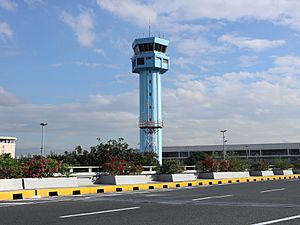
The French government funded a study that led to the terminal's construction and submitted the review to the Philippine government in 1990. In 1991, the French government provided a 30-million-franc soft loan to the Philippine government to fund the detailed architectural and engineering design. ADP finished the design in 1992. The Japanese government followed suit in 1994, providing an 18.12-billion-yen soft loan to the Philippine government to finance 75% of the construction costs and the entirety of the supervision costs. The construction of the terminal officially began on December 11, 1995, and the Philippine government took over the completed terminal on December 28, 1998. The terminal became fully operational in 1999.
In August 2014, authorities announced a plan to expand Terminal 2, incorporating a structure to interconnect Terminals 1 and 2. The plan also called for demolishing the adjacent unused Philippine Village Hotel complex and relocating a fuel depot.
Rehabilitation of the terminal began in September 2018, and by February 16, 2021, the expanded Terminal 2 was inaugurated. The expansion added an additional 2,800 square meters (30,000 sq ft) to the terminal area.
Terminal 2 once exclusively served as the hub for Philippine Airlines and its regional affiliate, PAL Express. This terminal facilitated both domestic and international flights for these airlines, notwithstanding the operation of select PAL Express flights from Terminal 3. Since July 1, 2023, Terminal 2 has been converted to exclusively serve domestic flights of PAL Express, Philippine Airlines, Philippines AirAsia, and Royal Air Philippines.
Terminal 3
Terminal 3, the newest and largest terminal, covers 182,500 square meters (1,964,000 sq ft) and extends 1.2 kilometers (0.75 mi), occupying a 63.5-hectare (157-acre) site on Villamor Air Base. The terminal partially opened on July 22, 2008, increasing the airport's capacity by 13 million passengers. The terminal's development, part of the 1989 expansion plan, commenced in 1997 but was beleaguered by legal battles, red tape, and arbitration cases in the United States and Singapore, as well as technical and safety issues that led to repeated delays. Japan-based Takenaka Corporation undertook the terminal's rehabilitation, and it became fully operational on July 31, 2014.
Skidmore, Owings and Merrill designed the US$640 million terminal, which has 20 jet bridges and four remote gates served by apron buses. The terminal's apron area spans 147,400 square meters (1,587,000 sq ft) and can service up to 32 aircraft simultaneously. It has the capacity to serve 33,000 passengers per day or 6,000 per hour. Since April 2017, a 220-meter long indoor footbridge called Runway Manila has been connecting the terminal to Newport City.
Since its inauguration, Terminal 3 has predominantly catered to Cebu Pacific's domestic and international operations, and since 2014, the international flights of the AirAsia Group. In addition, Terminal 3 is served by seventeen other foreign airlines, most of which formerly operated at Terminal 1.
Terminal 4
Constructed in 1948, Terminal 4, also known as the Manila Domestic Passenger Terminal or the Old Domestic Terminal, is the first and original structure of the airport, as well as its oldest and smallest terminal. Positioned on the old Airport Road, the Domestic Terminal is located near the north end of Runway 13/31.
Since 2023, Terminal 4 has been specifically assigned for turboprop aircraft, functioning exclusively with ground-loaded gates. This terminal, which accommodates up to three million passengers annually, primarily hosts domestic flights by regional airlines such as AirSWIFT, Cebgo, and Sunlight Air.
In response to the COVID-19 pandemic, the airport authority closed Terminal 4 to minimize operating costs, while the remaining three terminals resumed operations in June 2020 upon the lifting of the enhanced community quarantine in Luzon. During its closure, the terminal was utilized as a vaccination site for airport employees. Terminal 4 resumed its operations on March 28, 2022.
Structures and facilities
Runways
NAIA's primary runway is 3,737 meters (12,260 ft) long and 60 meters (200 ft) wide, running at 061°/241° (designated as Runway 06/24). Its secondary runway is 2,258 meters (7,408 ft) long and 45 meters (148 ft) wide, running at 136°/316° (designated as Runway 13/31). The primary runway was oriented at 06/24 to harness the southeast and southwest winds. Of the 550 daily flights, 100 take the secondary runway. It mainly caters to private planes and propeller aircraft such as the ATR 72-500, Airbus A320, and Airbus A321 aircraft and acts as the main runway of the NAIA Terminal 4.
Runway 13/31 closed in 2020 for rehabilitation. The runway was reopened on February 16, 2021, along with a newly constructed taxiway.
Third runway plan
Former Transportation Secretary Joseph Abaya proposed a new runway adjacent to the existing Runway 06/24. The proposed runway has a length of 2,100 meters (6,900 ft) that could allow the landing of an Airbus A320 and increase capacity from 40 planes per hour to 60–70. A consultant hired by the government, building another terminal to be less disruptive.
Previously, the Japan International Cooperation Agency proposed Sangley Point in Cavite as the site of an international airport serving the Greater Manila Area, meaning Sangley could serve as NAIA's third runway.
Maintenance

Lufthansa Technik Philippines (LTP) (formerly PAL Technical Center) was founded in 2000 as a joint venture of German firm Lufthansa Technik (51%) and Philippine aviation service provider MacroAsia Corporation (49%). Lufthansa Technik Philippines offers customers aircraft maintenance, repair, and overhaul (MRO) services.
The company performs maintenance checks for the Airbus A320 family and A330/A340 aircraft. Seven hangar bays and workshops provide industry standard maintenance, major modifications, cabin reconfigurations, engine maintenance, and painting for the A320 family, A330/A340, as well as the Boeing 747-400 and 777 aircraft. A new widebody hangar was recently added to meet the increasing demand for A330/A340 maintenance.
The company also opened an Airbus A380 maintenance hangar to allow the aircraft to be repaired at the airport facility. It also provides technical and engineering support for the entire Philippine Airlines fleet and other international airline fleets.
Aviation Partnership (Philippines) Corporation is SIA Engineering's third-line maintenance joint venture outside Singapore. The joint venture of SIA Engineering Company (51%) and Cebu Pacific Air (49%) provides line maintenance, light aircraft checks, technical ramp handling, and other services to Cebu Pacific Air and third-party airline customers.
Training
Philippine Airlines (PAL) operates the PAL Learning Center within the airport's premises. The center includes training facilities for pilots and cabin crew, catering services, a data center, and an Airbus A320 flight simulator.
DHL
The airport is a gateway facility for DHL. On March 12, 2006, the company opened its first quality control center.
Airlines and destinations
Passenger
| Airlines | Destinations |
|---|---|
| Air China | Beijing–Capital, Chengdu–Tianfu
|
| Air Juan | Busuanga
|
| Air Niugini | Port Moresby
|
| AirAsia | Kuala Lumpur–International
|
| AirSWIFT | Busuanga, El Nido, Sicogon, Tablas
|
| All Nippon Airways | Tokyo–Haneda, Tokyo–Narita
|
| Asiana Airlines | Seoul–Incheon
|
| Cathay Pacific | Hong Kong
|
| Cebgo | Busuanga, Caticlan, Cebu, Legazpi, Masbate, Naga, San Jose (Mindoro), Siargao
|
| Cebu Pacific | Bacolod, Bandar Seri Begawan, Bangkok–Suvarnabhumi, Beijing–Capital, Butuan, Cagayan de Oro, Caticlan, Cauayan, Cebu, Cotabato (suspended), Davao, Denpasar, Dipolog, Dubai–International, Dumaguete, Fukuoka, General Santos, Guangzhou, Hanoi, Ho Chi Minh City, Hong Kong, Iloilo, Jakarta–Soekarno-Hatta, Kalibo, Kota Kinabalu, Kuala Lumpur–International, Laoag, Legazpi, Macau, Melbourne, Nagoya–Centrair, Osaka–Kansai, Ozamiz, Pagadian, Puerto Princesa, Roxas, Seoul–Incheon, Shanghai–Pudong, Shenzhen, Singapore, Sydney, Tacloban, Tagbilaran, Taipei–Taoyuan, Tokyo–Narita, Tuguegarao, Virac, Xiamen, Zamboanga
|
| China Airlines | Kaohsiung, Taipei–Taoyuan
|
| China Eastern Airlines | Shanghai–Pudong
|
| China Southern Airlines | Guangzhou
|
| Emirates | Dubai–International
|
| Ethiopian Airlines | Addis Ababa
|
| Etihad Airways | Abu Dhabi
|
| EVA Air | Taipei–Taoyuan
|
| Gulf Air | Bahrain
|
| Hong Kong Airlines | Hong Kong
|
| Japan Airlines | Tokyo–Haneda, Tokyo–Narita
|
| Jeju Air | Seoul–Incheon
|
| Jetstar Asia | Osaka–Kansai (resumes November 24, 2023), Singapore
|
| Jetstar Japan | Nagoya–Centrair, Tokyo–Narita
|
| KLM | Amsterdam, Kuala Lumpur–International (ends October 28, 2023)
|
| Korean Air | Seoul–Incheon |
| Kuwait Airways | Kuwait City
|
| Malaysia Airlines | Kuala Lumpur–International
|
| Oman Air | Muscat
|
| PAL Express | Bacolod, Basco, Busuanga, Butuan, Cagayan de Oro, Calbayog, Catarman, Caticlan, Cebu, Cotabato (suspended), Davao, Dipolog, Dumaguete, General Santos, Iloilo, Kalibo, Laoag, Legazpi, Naga, Ozamiz, Pagadian, Puerto Princesa, Roxas, San Jose de Buenavista, Siargao, Tacloban, Tagbilaran, Zamboanga
|
| Philippine Airlines | Bangkok–Suvarnabhumi, Beijing–Capital, Brisbane, Busan, Cebu, Dammam, Davao, Denpasar, Doha, Dubai–International, Fukuoka, General Santos, Guam, Guangzhou, Hanoi, Ho Chi Minh City, Hong Kong, Honolulu, Jakarta–Soekarno-Hatta, Kuala Lumpur–International, Los Angeles, Macau, Melbourne, Nagoya–Centrair, New York–JFK, Osaka–Kansai, Perth, Phnom Penh, Port Moresby, Quanzhou, Riyadh, San Francisco, Seoul–Incheon, Shanghai–Pudong, Singapore, Sydney, Taipei–Taoyuan, Tokyo–Haneda, Tokyo–Narita, Toronto–Pearson, Vancouver, Xiamen Seasonal charter: Medina, Yangyang |
| Philippines AirAsia | Bacolod, Bangkok–Don Mueang, Cagayan de Oro, Caticlan, Cebu, Davao, Denpasar, Guangzhou, Hong Kong, Iloilo, Kalibo, Kaohsiung, Kota Kinabalu, Macau, Osaka–Kansai, Puerto Princesa, Roxas, Seoul–Incheon, Shanghai–Pudong, Shenzhen, Tacloban, Tagbilaran, Taipei–Taoyuan, Tokyo–Narita
|
| Qantas | Sydney
|
| Qatar Airways | Doha
|
| Royal Air Philippines | Caticlan, Lal-lo, Nanning
|
| Royal Brunei Airlines | Bandar Seri Begawan
|
| Saudia | Jeddah, Riyadh
|
| Scoot | Singapore
|
| Singapore Airlines | Singapore
|
| SkyJet Airlines | Busuanga, San Vicente
|
| Starlux Airlines | Taipei–Taoyuan
|
| Sunlight Air | Charter: Busuanga, Camiguin, Caticlan, Naga, San Vicente, Siargao
|
| Thai Airways International | Bangkok–Suvarnabhumi
|
| Turkish Airlines | Istanbul
|
| United Airlines | Guam, Koror, San Francisco (resumes October 30, 2023)
|
| XiamenAir | Quanzhou, Xiamen
|
| Zipair Tokyo | Tokyo–Narita |
Cargo
| Airlines | Destinations |
|---|---|
| Air Hong Kong | Hong Kong
|
| ANA Cargo | Tokyo–Narita
|
| China Airlines Cargo | Singapore, Taipei–Taoyuan
|
| Hong Kong Air Cargo | Hong Kong
|
| Korean Air Cargo | Seoul–Incheon, Singapore
|
| MASkargo | Kuala Lumpur–International
|
| SF Airlines | Shenzhen
|
| YTO Cargo Airlines | Hangzhou, Shenzhen |
Statistics
Data from Airports Council International and the Manila International Airport Authority.
| Year | Passengers | % change | Aircraft movements | % change | Cargo volume (in tonnes) | % change |
|---|---|---|---|---|---|---|
| 2003 | 12,955,809 | N/A | N/A | N/A | N/A | |
| 2004 | 15,186,521 | N/A | N/A | N/A | N/A | |
| 2005 | 16,216,031 | N/A | N/A | N/A | N/A | |
| 2006 | 17,660,697 | N/A | N/A | N/A | N/A | |
| 2007 | 20,467,627 | N/A | N/A | N/A | N/A | |
| 2008 | 22,253,158 | N/A | N/A | N/A | N/A | |
| 2009 | 24,108,825 | 186,966 | 348,994.25 | |||
| 2010 | 27,119,899 | 200,107 | 425,382.71 | |||
| 2011 | 29,552,264 | 217,743 | 410,377.05 | |||
| 2012 | 31,878,935 | 235,517 | 460,135.15 | |||
| 2013 | 32,865,000 | 237,050 | 457,077.17 | |||
| 2014 | 34,015,169 | 236,441 | 520,402.63 | |||
| 2015 | 36,681,601 | 249,288 | 586,890.53 | |||
| 2016 | 39,516,782 | 258,313 | 630,165.69 | |||
| 2017 | 42,022,484 | 258,366 | 662,256.99 | |||
| 2018 | 45,082,544 | 259,698 | 738,697.94 | |||
| 2019 | 47,898,046 | 277,530 | 721,708.09 | |||
| 2020 | 11,145,614 | 91,067 | 533,955.78 | |||
| 2021 | 8,015,385 | 121,095 | 588,370.92 | |||
| 2022 | 30,961,467 | 246,724 | 402,732.26 |
- Notes
Ground transport
Inter-terminal transport
MIAA runs a shuttle bus system that connects the terminals for passengers making connections.
Philippine Airlines operates an airside shuttle service between Terminals 1, 2, and 3.
Local connections
Bus
Ultimate Bus Experience (UBE Express) operates a Premium Airport Bus Service that connects terminals, hotels, and commercial areas in Manila, Makati, Muntinlupa, Quezon City, Pasay, and Parañaque, all in Metro Manila, and the city of Santa Rosa in Laguna. It stops at JAM Liner, Philtranco and Victory Liner terminals in Pasay for passengers going to/coming from the provinces of Northern and Southern Luzon. Passengers load exclusively at Terminal 3 and drop-off at any of the four Terminals.
HM Transport provides an Airport loop shuttle bus and Premium Point-to-point bus service from Taft Avenue MRT-3 station and Alabang in Muntinlupa to Terminal 3. Genesis Transport also provides Premium Point-to-point bus service to Clark from Terminal 3. Saulog Transit provides Premium Point-to-point bus service to Sangley Point Airport in Cavite City.
City bus routes also connect the airport to Diliman in Quezon City and Balagtas and San Jose del Monte in Bulacan, respectively.
Jeepney
All four terminals are served by local jeepney routes serving Parañaque and Pasay.
Rail
The airport is connected, albeit indirectly, by rail: Baclaran station of the Manila LRT Line 1 and Nichols station of the Philippine National Railways both serve the airport complex.
Road
The NAIA Expressway/Skyway is the first airport expressway and second elevated tollway in the Philippines. It starts from Sales Interchange of Skyway at the boundary of Pasay and Taguig and ends in Entertainment City, Parañaque. Access ramps connect with Terminals 1, 2, and 3 and with Macapagal Boulevard for motorists and commuters traveling to/from Manila and Manila-Cavite Expressway or CAVITEx for motorists and commuters travelling to/from Caviteprovince.
Renaming proposals
Repeated efforts to rename the airport have not succeeded. In May 2018, lawyer Larry Gadon led an online petition at change.org aiming to restore the original name of the airport, Manila International Airport (MIA). Gadon said the renaming of MIA to NAIA in 1987 was "well in advance of the 10-year prescription period for naming public sites after dead personalities".
In June 2020, House Deputy Speaker Paolo Duterte, citing the need of the airport to represent the Filipino people, filed a bill seeking to rename the airport to Paliparang Pandaigdig ng Pilipinas. The bill was coauthored by Marinduque Representative Lord Allan Velasco and ACT-CIS Representative Eric Go Yap.
In August 2020, Gadon filed a petition before the Supreme Court questioning the validity of Republic Act No. 6639, the law that named it NAIA. Gadon asserted that Aquino was not among the "pantheon" of the country's declared official heroes. A month later, the Supreme Court unanimously denied the petition to nullify the law for lack of merit.
In April 2022, Duterte Youth Representative Ducielle Cardema filed a bill returning the airport to its original name, claiming the name should not have been "politicized in the first place". Cardema tried again in July 2022.
In June 2022, Arnolfo Teves Jr. filed a bill renaming the airport to Ferdinand E. Marcos International Airport after former president Ferdinand Marcos, who authorized the airport's rehabilitation and development via an executive order in 1972. Teves stressed that it is "more appropriate to rename it to the person who has contributed to the idea and execution of the said noble project".
Accidents and incidents
- On July 25, 1971, a Pan American World Airways Boeing 707-321C named "Clipper Rising Sun" was on a cargo flight from San Francisco to Saigon. While on a VOR/DME approach to Manila runway 24, the aircraft struck Mount Kamunay at an altitude of 770 meters (2,525 ft). The four occupants were killed.
- On November 15, 1974, an Orient Air System and Integrated Services Douglas C-47A registered RP-C570 was damaged beyond repair after a forced landing in a paddy field shortly after take-off following failure of the starboard engine. One of the eight people on board was killed.
- On February 7, 1980, a China Airlines Boeing 707 from Taipei Chiang Kai-Shek International Airport operating as Flight 811 undershot the runway on landing and caught fire, causing two fatalities.
- On September 15, 1981, a Korean Airlines Boeing 747 originating from Seoul, South Korea, and bound for Zürich, Switzerland, overshot the runway during takeoff and hit the airport perimeter fence, with its nose blocking traffic on the service road of South Luzon Expressway. The plane had a one-hour layover in Manila when the accident happened. Forty of the 332 passengers and 20 crew were injured.
- On December 13, 1983, a Philair Douglas C-47B registered RP-C287 crashed shortly after takeoff following an engine failure. The aircraft was on a non-scheduled passenger flight. All ten people on board survived.
- On April 28, 1989, a MATS Douglas C-47A registered RP-C81 crashed shortly after takeoff on a non-scheduled domestic passenger flight to Roxas Airport following an engine failure. MATS did not have a licence to fly passengers. Seven of the 22 passengers were killed. The aircraft had earlier made a forced landing on a taxiway.
- On May 6, 1989, a Manila Aero Transport System (MATS) Douglas C-47A registered RP-C82 crashed on takeoff following an engine failure. The aircraft was on a domestic non-scheduled passenger flight, although it was not licensed to carry passengers. All 18 people on board survived.
- On July 21, 1989, a Philippine Airlines BAC One-Eleven operating Flight 124 overran a runway in poor visibility and heavy rain. No passengers or crew were killed but eight people on the ground were killed when the jet crossed a road.
- On May 11, 1990, a Philippine Airlines Boeing 737-300 operating Flight 143 suffered an explosion in the center fuel tank near the terminal while preparing for takeoff. The fire and smoke engulfed the aircraft before it could be evacuated. The explosion was similar to what happened to TWA Flight 800 six years later. Eight people died.
- On May 18, 1990, an Aerolift Philippines Beechcraft 1900C-1 operating a domestic scheduled passenger flight bound for Surigao Airport crashed into a residential area following takeoff. The aircraft reportedly suffered an engine failure. All 21 occupants and 4 people on the ground were killed.
- On September 4, 2002, an Asian Spirit de Havilland Canada Dash 7-102 operating Flight 897 to Caticlan, carrying 49 occupants. On approach to Caticlan Airport, the right main gear failed to deploy. The approach was abandoned and the crew decided to return to Manila for an emergency landing. The plane circled for about 35 minutes over Las Piñas to burn off fuel. The crew then carried out an emergency landing with the right gear retracted. After touchdown, the aircraft swerved off the runway onto a grassy area. There were no reported injuries or fatalities, but the aircraft was written off.
- On November 11, 2002, a Laoag International Airlines Fokker F27 operating Flight 585 took off from Manila runway 31 just after 6 o'clock for a flight to Laoag International Airport. Shortly after takeoff, trouble developed in the left engine. The pilot declared an emergency and attempted to land, but decided at the last minute to ditch into the sea. The aircraft broke up and sank in the water to a depth of about 18 meters (60 ft). 19 of the 34 occupants were killed.
- On August 23, 2009, a South East Asian Airlines Dornier 328 registered RP-C6328 operating Flight 624 was hit by strong crosswinds when decelerating after landing on runway 13. The aircraft veered off the runway and came to a stop in the grass. None of the 32 passengers and 3 crew was injured. The airport had to be temporarily closed to tow the aircraft away.
- On October 17, 2009, a Victoria Air Douglas DC-3, registered RP-C550, crashed shortly after takeoff on a flight to Puerto Princesa International Airport after an engine malfunctioned. All on board died.
- On December 10, 2011, a Beechcraft 65–80 Queen Air cargo plane en route to San Jose crashed into houses next to Felixberto Serrano Elementary School in Parañaque, Metro Manila. The plane crashed after takeoff into the school. The crash was attributed to pilot error. At least 14 people including 3 crew members on board the aircraft died, and over 20 were injured. Approximately 50 houses in the residential area were set ablaze.
- On August 16, 2018, Xiamen Airlines Flight 8667 crash-landed amidst heavy monsoon rains. The 737-800 skidded off the end of the runway. All 157 passengers and crew were unharmed, however, the aircraft was written off. According to Flightradar24 data, the flight aborted its first landing attempt.
- On December 14, 2019, Jetstar Japan Flight 40, an Airbus A320 bound for Narita, experienced a runway excursion while positioning for takeoff at Runway 13/31. All 140 passengers and crew evacuated safely.
- On March 29, 2020, a Lionair IAI Westwind registered RP-C5880 burst into flames on runway 24 during take off. The plane was conducting a medical evacuation mission bound for Haneda Airport, Japan. All eight occupants consisting of three aircraft crew, three medical crew, and two passengers died.
- On March 8, 2022, Cebgo Flight 6112 from Naga utilizing an ATR 72-600 aircraft experienced a runway excursion while landing. Following the incident, the 46 passengers and crew disembarked safely, and no injuries were reported.
- On June 20, 2022, Saudia Flight 862 from Riyadh veered off a taxiway after landing. All 420 passengers and crews disembarked aircraft with no injuries.
- On January 1, 2023, a power outage at CAAP's Air Traffic Management Center in the airport forced 282 flight cancellations or diversions and left 56,000 passengers stranded.
- On May 1, 2023, a power outage forced 48 Cebu Pacific flight cancellations, affecting 9,391 passengers.
- On June 10, 2023, a 37-minute-long power outage affected Terminal 3, causing long lines and seven delayed flights.
See also
 In Spanish: Aeropuerto Internacional Ninoy Aquino para niños
In Spanish: Aeropuerto Internacional Ninoy Aquino para niños
- Nichols Field
- Colonel Jesus Villamor Air Base
- List of airports in the Philippines
- List of airports in the Greater Manila Area




